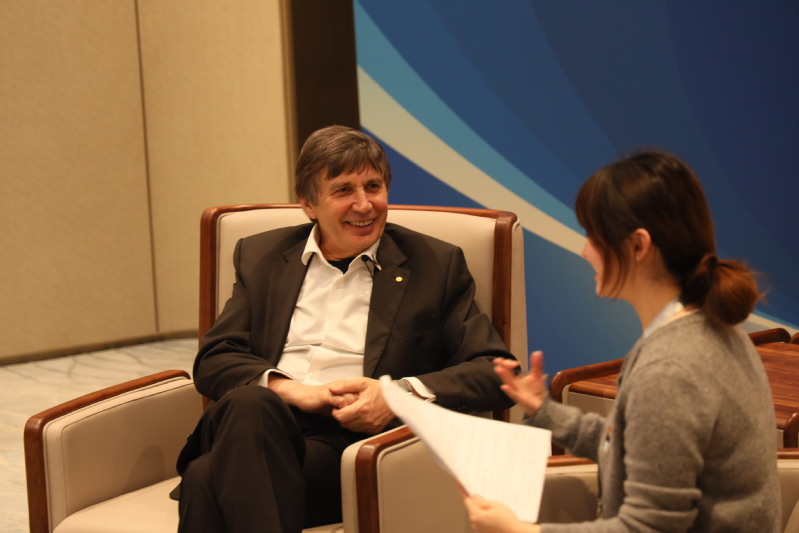By Cheng Qiyue
On the opening day of the 2024 WLAForum in Lingang, Shanghai, Andre Geim, the Nobel Prize-winning physicist, quietly made his entrance. Tall, silver-haired, and with a penetrating gaze, the Russian-born scientist drew attention even before he spoke.
“You can call me ‘Maozi,’” he joked, blending humor with a dash of Chinese as he broke the ice with the media team preparing his microphone. For Geim, known for his groundbreaking work with graphene—a material discovered through his now-famous “scotch tape” method—this understated humor is as integral to his personality as his trailblazing scientific achievements.
Twenty years after his discovery, graphene is a buzzword worldwide, hailed as the wonder material of our time. Yet Geim remains a realist. “Science isn’t magic, and breakthroughs take time,” he said, emphasizing that while graphene has many uses, the leap from lab discovery to real-world applications often requires patience and perseverance.
From Nobel-Prize Discovery to Mainstream Applications
Graphene—a single layer of carbon atoms arranged in a two-dimensional lattice—is naturally occurring, though extremely difficult to isolate in pure form. In 2004, Geim and his collaborator Konstantin Novoselov managed to do just that through a novel yet deceptively simple technique: they peeled away at graphite with adhesive tape, thinning it down until only a single layer of graphene remained.

(Andre Geim being interviewed by the author of this article. Photographed by Zhang Xinyi.)
“Many researchers had graphite in their hands, but none thought to check what was left on the tape,” he recalled. The discovery set off a global wave of research into graphene’s unique properties—strength, flexibility, and conductivity—and applications soon followed, from electronics to biomedicine. Geim noted that the hype surrounding graphene also comes with inflated expectations: “Graphene is amazing, but it’s no magic wand. It takes years of refinement, testing, and funding before a lab discovery becomes part of everyday life.”
In an era where “fast success” dominates headlines, Geim warned against expecting scientific progress to follow the same timeline as a tech startup. “You write code, sell it, and a few years later you might be a billionaire,” he said. “But science doesn’t work that way. Real breakthroughs take decades. Look at Einstein’s relativity—practical applications like GPS only came much later. The science had to mature.”
Today, graphene’s impact is evident across industries, from smartphones to solar panels. “It’s likely there’s graphene in your Huawei phone, quietly improving its performance,” Geim mused, adding with a shrug, “Science works in small steps toward big impacts.”
“Measure Life by Experiences, Not Years”
When asked for his advice on training young scientists, Geim leaned back, crossed his legs, and, with a glint of mischief, threw the question back: “Well, you’re a Fudan student. Why don’t you answer that?”
The student interviewer replied, “I got the chance to interview you. I think that’s pretty cool.”
Geim cracked a smile and then offered a serious answer: “Make your work interesting—turn it into a hobby. If you find it dull, it’s not worth wasting your life on.”
This mix of dry humor and earnestness defines Geim, a scientist who’s never lost his sense of play. In 2000, his curiosity about what happens to objects in a 20-Tesla magnetic field led him to do something most would consider unconventional: he began tossing random objects into the field, eventually getting a frog to levitate.
“That was a rigorous scientific experiment,” he said, with a straight face that barely concealed his amusement. “Scientific breakthroughs often start with something that looks a little strange, an odd idea that reveals unexpected things.”

(The 2024 World Top Scientists Forum attracted many young people.Photo provided by the organizer.)
Geim’s magnetic field research, in fact, grew out of a question that seemed almost childishly simple: What would water do in a magnetic field? “Facilities like this have existed for decades, yet no one bothered with this simple, even slightly foolish-sounding question.”
Born in the former Soviet Union and living most of his life in Europe, Geim speaks with a rare blend of historical weight and playful insight. Reflecting on his approach to life, he said, “I don’t measure life in years—I measure it in experiences. It’s about how many interesting people you’ve loved, how many fascinating places you’ve seen, and how many stories you can tell.”
To Fudan’s young scholars, he shared this parting wisdom: “One day, you’ll look back, and if all you’ve done is eat, sleep, and drink, you’ll feel it was a waste. Make your life interesting, so when you’re my age, you’ll be proud of what you’ve lived.”
“Science Knows No Borders”
Geim’s influence in China runs deep. As a Foreign Member of the Chinese Academy of Sciences, he has mentored dozens of Chinese researchers, many of whom are now leading figures in graphene research. He co-founded the Shenzhen Geim Graphene Center with Tsinghua University’s Berkeley Institute in 2017, establishing a hub for graphene research that bridges China and the world.
“I’m no stranger to China. I’ve been here for academic collaborations many times,” he said, listing cities from Beijing to Xiamen. He praised China’s strides in applied sciences and its rapid progress, though he noted that foundational research still has room to grow.

(Andre Geim is interviewed by the author of this article. Photograph by Wu Jing.)
In his view, international collaboration is the cornerstone of scientific progress. “Science knows no borders,” he said. “Knowledge is a global resource, and sharing it strengthens everyone.” He expressed concern about the recent barriers to scientific cooperation, calling them “short-sighted,” but remains confident that science will overcome such obstacles.
Now a six-time participant in the World Laureates Forum, Geim sees it as a beacon of collaboration. “Bringing together the world’s best minds in one place is inspiring. I look forward to seeing this forum thrive in years to come.”

